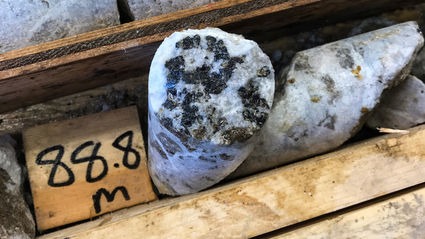Ore sorting shows promise at Pine Point
North of 60 Mining News – May 10, 2019
Last updated 9/25/2020 at 4:36pm

Osisko Metals Inc.
X-Ray transmission sensors, which can identify the density of the limestone, were the most efficient at sorting mineralized material from barren host rock at Pine Point.
Osisko Metals Inc. May 8 said that recent tests show that ore sorting shows the potential to reduce the costs to transport and process ore at a future mine at its Pine Point zinc project in Northwest Territories.
Ore sorting, which identifies and rejects unmineralized rock prior to feeding ore into a mill, is gaining popularity as a means to improve ore grades and reduce processing costs at mines.
Osisko sent 800 kilograms (0.8 metric tons) of mineralized samples from Pine Point to Steinert Labs in Kentucky to see if this technique could work as a way to sort material from the various pits at a future Pine Point mine prior to transporting ore to a central processing facility on the property.
Various sensors can be used to identify mineralized material. In the case of Pine Point, Steinert found that X-ray transmission sensors, which measure the density of the sample, were the most efficient at sorting mineralized material from barren host rock. In testing, particles with a density that resembles limestone were rejected.
The initial X-ray transmission material sorting tests recovered an average of 92.6 percent of the zinc and 97.8 percent of the lead contained in the samples while rejecting roughly half the material.
An X-ray transmission presorting plant could be set up near the mining area, which would reduce the amount and improve the grade of ore trucked to the mill facility.
"This round of test work expands upon previous material sorting studies and conclusively confirms Pine Point material is amenable to XRT pre-concentration. Indications are that roughly half of the waste rock material can be rejected near potential pit operations with less than 10 percent loss of both zinc and lead mineralization," said Osisko Metals Jeff Hussey. "The benefits of incorporating a pre-concentration process at Pine Point would be to significantly reduce haulage costs and reduce the material throughput in the mill. Based on the combination of these benefits, project economics would improve from substantial operating and capital cost savings."
The company had the pre-concentrated material from the XRT transmission sorting tested for recoveries using floatation.
Production records from Cominco Ltd.'s historical production records at Pine Point shows that floatation recovered 91.91 percent of the zinc into a concentrate grade of 58 percent zinc; and 88.69 percent of the lead in a separate concentrate averaging 75.68 percent lead.
One first float phase test was performed on each of the fourteen XRT material sorter concentrates to confirm that similar metal recoveries can be achieved as those listed in the historical records. Osisko said early results from this testing are encouraging.
Optimization results from the floatation tests will be available shortly, and a complete flotation test work campaign is planned later this year to optimize recovery and operating parameters that would be closer to a full-scale concentrator performance forecast.
"One of the key benefits of the Pine Point project is the proven high metal recoveries using conventional flotation," said Hussey. "We believe Osisko Metals is well positioned to leverage both this excellent response to preconcentration techniques and the premium quality of potential production of Pine Point concentrates."
–SHANE LASLEY




Reader Comments(0)